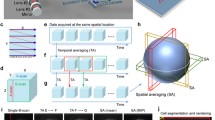Abstract
Purpose: The improved resolution and optical sectioning of a confocal microscope make it an ideal instrument for extracting three-dimensional information, especially from extended biological specimens such as human embryos. The staining of actin together with chromatin allowed us to specify the architecture of the embryo and the appearance of the nucleus.
Methods: F-Actin and chromatin distributions were visualized using laser scanning confocal microscopy in “fresh” and “cryopreserved” human preimplantation embryos obtained by in vitro fertilization.
Results: The current study revealed a high rate of multinucleation in arrested or poor-quality embryos (89%, in grade IV embryos).
Conclusions: Confocal microscopy revealed high levels of multinucleated blastomeres, suggesting that the probable cause of arrested development in these embryos was due to multinucleation of blastomeres.
Similar content being viewed by others
REFERENCES
Pawley JB: Handbook of Biological Confocal Microscopy. New York, Plenum Press, 1995
Paddock SW: Applications of laser scanning confocal microscopy in developmental biology. Bioessays 1994;16:357–364
White JG, Amos WB, Fordham M: An evaluation of confocal versus conventional imaging of biological structures by fluorescence light microscopy. J Cell Biol 1987;105:41–48
Hardy K, Winston RLM, Handyside AH: Binucleate blastomeres in preimplantation human embryos in vitro: Failure of cytokinesis during early cleavage. J Reprod Fertil 1993;98:549–558
Hardy K, Handyside AH, Winston RML: The human blastocyst: Cell number, death and allocation during late preimplantation development. In Vitro Dev 1989;107:597–604
Wulf E, Deboben A, Bautz FA, Faulstich H, Wieland T: Fluorescent phallotoxin, a tool for the visualization of cellular actin. Proc Natl Acad Sci USA 76;1979:4498–4502
Von Dassow G, Schubiger G: How an actin network might cause fountain streaming and nuclear migration in the syncytial Drosophila embryo. J Cell Biol 1994;127:1637–1653
Segal S, Casper RF: Progesterone supplementation increases luteal phase endometrial thickness and estradiol levels in in vitro fertilization. Hum Reprod 1992;7: 1210–1213
Dawson KJ, Margara RM, Hillier SG, Packham D, Winston N, Winston RML: Factors affecting success at the time of embryo transfer. Hum Reprod 1987;2(Suppl 1):39
Menezo Y, Guerin JF, Czyba JC: Improvement of human early embryo development in vitro by coculture on monolayers of Vero cells. Biol Reprod 1990;42: 301–306
Testart J, Lasalle B, Belaisch-Allart J, Forman R, Hazout A, Volante M, Frydman R: Human embryo viability related to freezing and thawing procedures. Am J Obstet Gynecol 1987;157:168–171
Sathananthan AH, Wood C, Leeton JF: Ultrastructural evaluation of 8–16 cell human embryos cultured in vitro. Micron 1982;13:193–203
Lopata A, Nayudu P, Jones G, Abramczuk J: The quality of human embryos obtained by in vitro fertilization. In Human In Vitro Fertilization, J Testart, R Frydman (eds). Amsterdam, Elsevier, 1985, pp 171–185
Van Blerkom J, Henry G, Porreco R: Preimplantation human embryonic development from polypronuclear eggs after in vitro fertilization. Fertil Steril 1984;41: 686–695
Trounson A, Sathananthan AH: The application of electron microscopy in the evaluation of two-to four-cell human embryos cultured in vitro for embryo transfer. J In Vitro Fert Embryo Transfer 1984;1:153–165
Plachot M, Mandelbaum J, Junca AM, De Grouchy J, Cohen J, Salat-Baroux J, Da Lage C: Morphologic, cytologic and cytogenetic studies of human embryos obtained by IVF. In In Vitro Fertilization. Proceedings of the Twelfth World Congress of Fertility and Sterility (Vol 2), SS Ratnam, ES Teoh (eds). Lancs, UK, Parthenon, 1986, pp 61–65
Tesarik J, Kopecny V, Plachot M, Mandelbaum J: Ultrastructural and autoradiographic observations on multinucleated blastomeres of human cleaving embryos obtained by in-vitro fertilization. Hum Reprod 1987;2:127–136
Winston NJ, Braude PR, Pickering SJ, George MA, Cant A, Currie J, Johnson MH: The incidence of abnormal morphology and nucleocytoplasmic ratios in 2-, 3-and 5-day human preembryos. Hum Reprod 1991;6:17–24
Balakier H, Casper RFJ: A morphologic study of unfertilized oocytes and abnormal embryos in human in-vitro fertilization. J In Vitro Fert Embryo Transfer 1991;8:73–79
Pickering SJ, Taylor A, Johnson MH, Braude PR: An analysis of multinucleated blastomere formation in human embryos. Mol Hum Reprod 1995:1 (see Hum Reprod 1995;10:1912–1922)
Wojcik C, Guerin JF, Pinatel MC, Bied V, Boulieu D, Czyba JC: Morphological and cytogenetic observations of unfertilized human oocytes and abnormal embryos obtained after ovarian stimulation with pure follicle stimulating hormone following pituitary desensitization. Hum Reprod 1995;10:2617–2622
Hardy K, Warner A, Winston RML, Becker DL: Expression of intercellular junctions during preimplantation development of the human embryo. Mol Hum Reprod 1996;2:621–632
Balakier H, Cadesky K: The frequency and developmental capability of human embryos containing multinucleated blastomeres. Hum Reprod 1997;12:800–804
Simerly C, Wu GJ, Zoran S, Ord T, Rawlins R, Jones J, Navara C, Gerrity M, Rinehart J, Binor Z, Asch R, Schatten G: The paternal inheritance of the centrosome, the cell's microtubule—organizing center, in humans, and the implications for infertility. Nature Med 1995;1:47–53
Brakenhoff GJ, van der Voort HTM, van Spronsen EA, Nanninga N: Three-dimensional imaging in fluorescence by confocal scanning microscopy. J Microsc 1989;153:151–159
Kligman I, Benadiva C, Alikani M, Munné S: The presence of multinucleated blastomeres in human embryos is correlated with chromosomal abnormalities. Hum Reprod 1996;11:1492–1498
Mottla GL, Adelman MR, Hall JL, Gindoff PR, Stillman RJ, Johnson KE: Lineage tracing demonstrates that blastomeres of early cleavage-stage human preembryos contribute to both trophectoderm and inner cell mass. Hum Reprod 1995;10:384–391
Mandelbaum J: La congélation des embryons humains. Contracept Fert Sex 1990;18:341–353
Kondo I, Suganuma N, Ando T, Asada Y, Furuhashi M, Tomoda Y: Clinical factors for successful cryopreserved-thawed embryo transfer. J Assist Reprod Genet 1996;13:201–206
Van den Abbeel E, Camus M, Van Waesberghe L, Devroey P, Van Steirteghem AC: Viability of partially damaged human embryos after cryopreservation. Hum Reprod 1997;12:2006–2010
Author information
Authors and Affiliations
Rights and permissions
About this article
Cite this article
Levy, R., Benchaib, M., Cordonier, H. et al. Laser Scanning Confocal Imaging of Abnormal or Arrested Human Preimplantation Embryos. J Assist Reprod Genet 15, 485–495 (1998). https://doi.org/10.1023/A:1022582404181
Issue Date:
DOI: https://doi.org/10.1023/A:1022582404181




